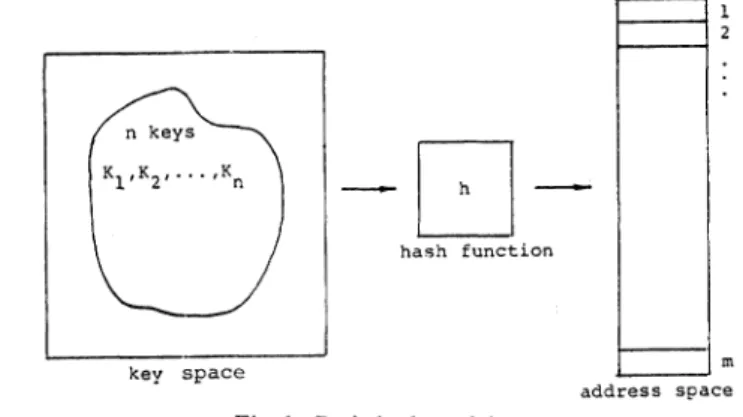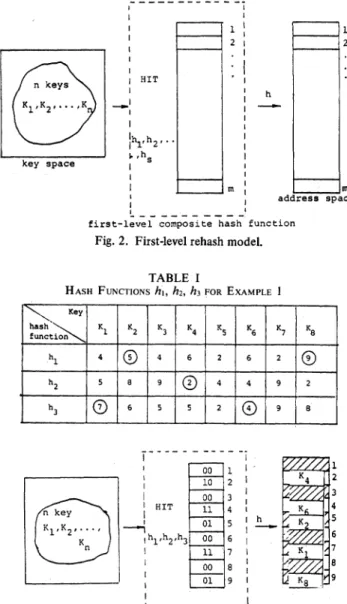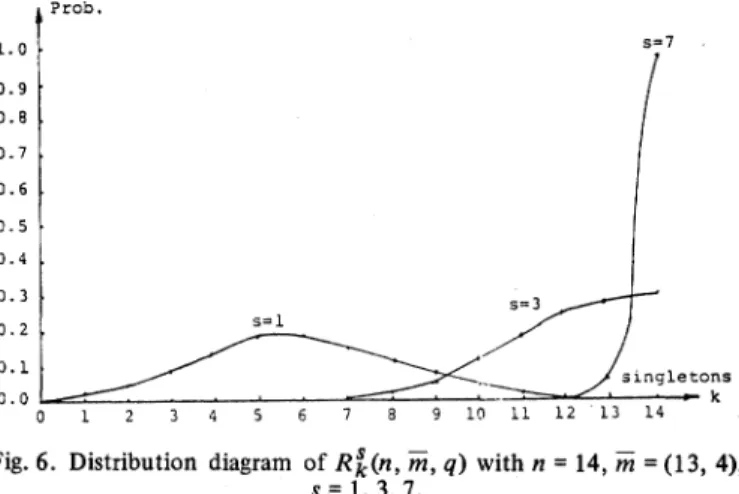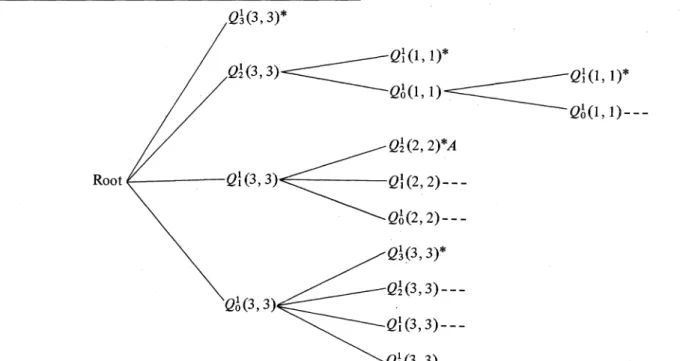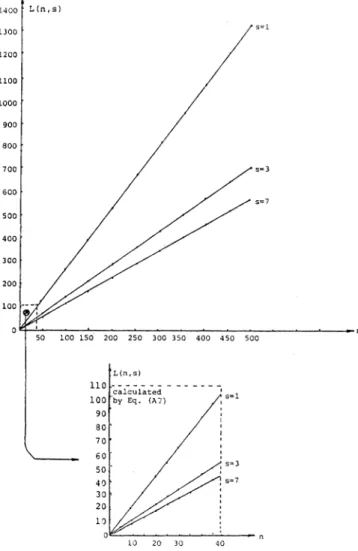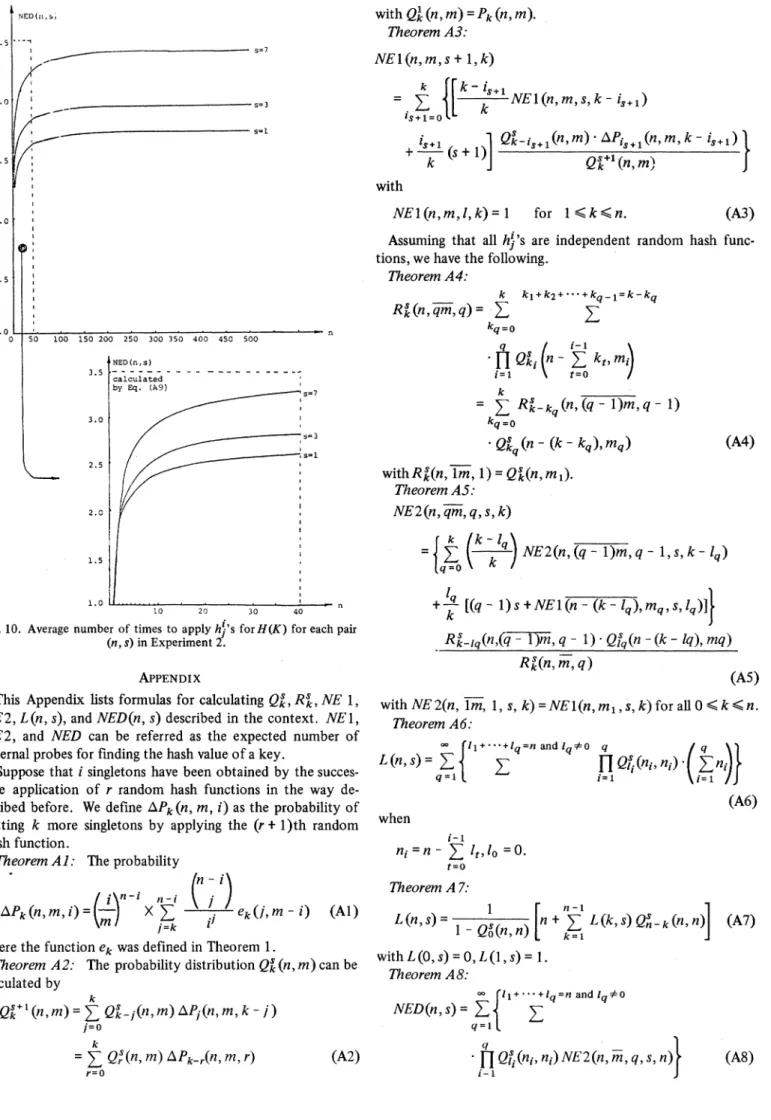[131 R. L.Mattson,J.Gecsei, D. R. Slutz, and I. L.Traiger, "Evalua-tiontechniques for storage hierarchies," IBM Syst. J., voL 9, pp. 78-117, 1970.
[14] J. B. Morris, "Demand paging through the use of workingsetson the MANIAC II," Commun. Ass. Comput. Mach., vol. 15, pp. 867-872, Oct. 1972.
[151 J.-F.Paris, personal communication, Feb. 1981.
[16] B. G. Prieve, "A page partition replacement algorithm," Ph.D. dissertation, Univ. California, Berkeley, 1974.
[17] J. Rodriguez-Rosell and J. P. Dupuy, "The design, implementa-tion, and evaluation of a working set dispatcher," Commun. Ass. Comput.Mach.,voL 16, pp.247-253, Apr. 1973.
[18] A. J. Smith, "A modified working set pagingalgorithm," IEEE Trans.Comput., voLC-25, pp.907-914, Sept. 1976.
[19] A. J. Smith, "Two simple methods for the efficient analysis of memory address trace data," IEEE Trans. Software Eng., vol. SE-3, pp. 94-101, Jan.1977.
[201 J. R. Spirn, "Program locality and dynamic memory manage-ment," Ph.D. dissertation,PrincetonUniv.,Mar. 1973.
Domenico Ferrari (M'67), for a photograph and biography, see p. 79 of the January1983 issue of this TRANSACTIONS
Yiu-Yo Yih received theB.E. degree in com-puter engineering from theUniversityof Michi-gan, Ann Arbor, and theM.S. degree in com-puter science fromtheUniversityof
California,
Berkeley.He joined
Bell
Laboratories,Holmdel,
NJ,
asamember ofthe technical staffin May 1980. * His interests include operating systems and pattem recognition. He iscurrently working
towards a Ph.D.degreein computerscience at RutgersUniversity.
The
Study
of
a
New
Perfect
Hash
Scheme
M.W. DU, MEMBER, IEEE,T. M. HSIEH, K. F. JEA, AND D. W. SHIEH
Abstract-Anewapproach isproposed for the design of perfect hash functions. Thealgorithms developed canbeeffectively appliedtokey setsof large size. The basic ideas employed in the construction are rehash and segmentation. Analytic results aregiven which are appli-cable when problem sizes are smalL Extensive experiments have been performed to test the approach for problems of largersize.
IndexTerms-Hashing, perfect hash functions, rehash, segmentation.
I. INTRODUCTION
ASHING has been considered as an effective means to
H
organize and retrieve data in program design and hasbeen widely used in databasemanagement,compiler construc-tion, and many other applications. In order to use hashing
techniques in a specificapplication, one hasto first choose a suitable hash function, then select a method for collision
resolution. Quite a number ofways have been proposedto design hashfunctions [2], [13], [16], [17],
[211.
Twocolli-sionresolving methods, chainingandopenaddressing,have also
been exploredinmany papers [12], [15] [17]
-[201,
[23]. Ifa hash function can be found whichisone-to-one from the set ofkeysin thekeyspace tothe addressspacethen that Manuscript receivedApril 20, 1981; revisedDecember27, 1982. This workwassupported in part by theNational Science CouncilofR.O.C. under Grant NSC-68E-0201-04(05). Partofthis paperwas presented atCOMPSAC'80,Chicago, IL, October 1980.M. W. Du is with the Institute of Computer Engineering, National ChiaoTungUniversity, Hsinchu, Taiwan, R.O.C.
T. M. Hsieh is with the Institute ofElectronic Engineering,National Chiao Tung University, Hsinchu, Taiwan, R.O.C. and the Department ofElectronic Engineering, Chung Yuan University, ChungLi, Taiwan, R.O.C.
K. F. Jea is with the Department of Computer Science, University ofWisconsin, Madison,WI53706.
D. W. Shieh is with the System Development Center, Institute for InformationIndustry, Taiwan, R.O.C.
hash functionwill becomemucheasiertousesincethe bother-some key collision problem can be avoided. There exist a numberof methodsfor the designofa one-to-one hash func-tion
[1], [3],
[8]-[10],
[22]
or called perfect hashingfunc-tion in
[221.
In suitable situations their methods mayyield good hash functions as far as thememory space usedor the execution timeareconcerned.In this paper an entirely newapproach isproposed for the design of
perfect
hash functions. An indicator table isusedin the construction of a perfect hash function with table
size in linear proportion to the number of keys. Compared
to other methods proposed in the literature for designing perfect hash functions
[1],
[3], [8]
-[101,
[22],
theconstruc-tion procedures here have the advantages that they are easy
to
implement
and can be effectively applied to key sets of largesize.The basic ideas employedinourconstructionarerehash and segmentation. In Sections II-IV we will show how random hash functions are organizedbyusingahashindicatortableto
construct a desired perfect hash function. Analytic resultsare
given
which
areapplicable
when problems sizesare small. InSection V, twoalgorithmsaredesigned for the construction of the hash indicator table. Extensive experiments have been performed to testthenewapproach forproblems of largesize.
Theresults are presented in Section VI.
Formulas for calculating probabilities and expectations dis-cussedinthe context arelistedinthe Appendix.
II. RANDOM HASH FUNCTIONS
We shall consider random hash function first. Fig. 1 shows
the basic model which will be considered throughout this paper. In the model, a set of nnonequal
keysK,
,K2,*,Kn
inthekeyspaceis mapped into anaddressspacewithmentriesIh hash function 1 2 key space m address space Fig.1. Basic hashmodel.
by a hash function h. No interrelations will be assumedto exist among the n keys. The keys can be thought ofasjust arbitrary binary strings. Therefore, the hashfunction canbe
fully characterized by the listing of the values h
(Ki)
for all1 .i.n, where 1
.h(Ki)<m.
h is called a random hash function whenever all theh(Ki)'s
are selected randomly from{
1, 2,
* m}Wesaythatacollisionoccursif forsomei#
j,
h(Ki)
=h(K1).
In such situation, we also say that
Ki
andK1
arecollided keys underh.Definition 1: h is a perfect hash function iff no collision
occurs inh.
We define belowaprobability which will beused to measure
thelikelihoodof constructingperfect hashfunctions.
Definition 2: Let F be a set ofpossible distinct functions obtainable from a construction procedure P, with the
func-tions mapping from a set of keys into an address space. As-sume that there are
np
perfect hash functions amongthenFfunctions inF. If ahashfunctionh isselectedrandomly from
F, the probability of h being perfect, denoted as pbp(h), is
equalto
np/nF-It should be noted that h is a formal name representing a
function selectedrandomly fromF inDefinition 2. Itcanalso bethought ofastheformalnamerepresentingafunction
con-structed by the procedure P. Clearly,
pbp(h)
depends entirelyonhowprocedure P constructsperfect hash functions. Asan example,assumethat his amapping functionselected randomly from
Fn Xm,
the set ofallfunctions thatmap nkeys into an address space with m entries. The chances that h is aperfect hash function are ordinarily quite small. Actually,
pbp(h)=0
ifn>m,
and isequal
tom!/(m- n)!
X(1/ma)if n < m. When n =m =10 pbp(h)=0.0003629. Even when
m is much larger than n, the probability is still very small.
Whenn=23 andm =365,wehavethefamous"birthday
para-dox"
[7],
[13]. The probabilityisonly0.4927,still less thanhalf!
We say that a hash function h has k singletons if thereare k entries in the address space with a single key hashed by h to each of them. Ingeneral, we canfindthe probability for
hhaving exactlyksingletons by thefollowing theorem. Theorem 1: Assume that h is arandom hashfunctionfrom n keysto anaddress space of size m. Let us denote the
proba-bility distribution of the number of singletons
k(O
< k < min(m,
n)) asPk (n, m). ThenPk(n,m)-=e(nm)
where
ek )n !mJ)nnk kLm kJ
(m-r-k)n-r-k
This theorem can be proved by first findingthe numberof
possible h functions having atleast
i
singletons,usingthe ordi-nary enumerator (xl +x2 +* +Xmn)n
of the number ofways in which n distinct objects can be distributed into m
distinct cells, then applying the principle of inclusion and exclusion [6], [14]
togetpk(n,m).
By using the distribution function in Theorem 1, closed
formfor the mean ofPk (n, m)canbe found
[41,
[I
1] asE[k] =nX(1- (2)
Let us assumethat n=am, theformula n X (1 -
(lm))n-1
approaches nX e-° when n becomes very
large.
Therefore,ish is selectedrandomly from
Fnxm,
ordinarily
it will be far from being aperfect hashfunction. To improvethis situation,some information about the keys should be usedtoconstruct the hashfunction. In the next section we use rehashto con-struct a new hash function from a numberof hash functions selected from
Fnxm
. Information relatedtothekeysand thehash functions selected is kept ina table called hashindicator
table(HIT).
III. FIRST LEVEL REHASH
Fig. 2 shows the first-level rehash model where the hash function h is constructed from a number of hashfunctions,
hl,
h2,* * * ,hs,
selectedrandomly from Fnm,
Inthefigure,the HIThas the same number ofentries asthatof theaddress
space. In fact, entry d in HITcorresponds to entry d inthe
addressspace.
The contents in HIT can be defined by thefollowing Pidgin Algolprogram.
Procedure1 [Procedureto ConstructFirst-Level
HIT]:
begin
KEYSET :={K1 K2
Kn};
clearallentiresofHIT; forj:= 1 step 1 untilsdo beginforallelementsinKEYSET do
HIT(d) :=jif
HIT(d)
=0andhj(Kr)
= dforoneandonlyoneKrin KEYSET;
KEYSET KEYSET - {Kr
IKr
satisfiesthe aboveconditions},
end end
The first-level compositehash function hcan be defined as
follows:
h(K)=hi(K)=d
ifHIT(hr(K))
$rforr<i
andHIT(h1(K))=i,
=undefined otherwise. (3)
(1) It can be seen that if q hash functionsare selectedfor com-posingh,atable HIT ofwidth
[log2 (q
+1)1
bits isrequired.
2-HIT t
1hi
h2 *tI ~~~m
addx
first-level composite hash function
Fig. 2. First-level rehash model.
0. 6 1 2 o.51 0.4 0.31 0.2 0.1 0.C sm ress space TABLE I
HASH FUNCTIONs h1, h2, h3FOREXAMPLE 1
Key hash KI K2 K K4 K5 K6 K7 K functio~n 2 3 4 h1 | 4 ( 4 6 2 6 2 h2 |5 a 9 () 4 4 9 2 h3 6 5 5 2 9 8 KlI . . 00 1 I 10 2 00 3 HIT 11 4 01 5 h1th2,h3 00 6 11 7 00 8 . I 01 9 .L_ _ __ _ --_-__ K4 11- KS; , aK2 K ) K 1 2. 3 4 5 6 7 8 9
Fig. 3. HIT constructed by Procedure 1 ofExample1.
Tofindh(K)forakeyK in thekeyspace,weapplythehash
functions
hI,
h2,* **,h.
on K in turn untilHIT(hi(K))=i.
Ifthesearchfails, h(K) is undefined.
Example 1: Assume that the key setis{K1,K2,.* * ,K8},
and that the address space is from 1 to9. The hash functions
selected are
hl,
1h2,h3, as defined by Table I. Thecircles ineach row-h in the table indicate where the
hi
contributessingletons.-The HIT constructed by Procedure 1 is given in Fig. 3. We can see thatK2 and K8 find their right places by
h,
. K4 byh2,K1 and K6 byh3. Note that h2(
Q)
=5 is asingleton inthe second rowofh2, however, since5has been already
occu-pied by K2 through the mapping of
h,,
K1 doesnot find itsright position byh22. The mapping ofthe composedfunction hisundefinedontheremainingkeys K3,
Ks,
andK7.Let us see how h(K6)can be calculated. When
h,,
h2, h3are-applied on K6 in turn,wehave HIT(h1(K6))=HIT(6)=
(00)2 =0 1, HIT(h2(K6)) =HIT(4) =( )2 = 3 = 2, HIT
(h3(K6))-HIT(4)=(11)2 3 =3. Therefore, h(K6)=4.
Suppose that k'keys have been hashed successfully into the address space afters hash functions of
hj1's
are appliedin theway described above. Givenany one keyK of thesekkeys, we can apply the
h,,
h2,* ,h.
successively, consulting theHIT table, to find h(K). We defineNE1- (n,m, s, k)as the
Qk(n,m)
s=7
s=3 s=1
1 2 3 4 5 6 7 8 9 10 11 12 13 14
Fig.4. Distribution diagram of
Q9(n,
m) with n = 14, m =17, and s=1, 3,7.expected number of times it is required to apply
hi's
for cal-culating h (K) with K amongthese k keys.Let
Q'(n,
m) be the probability of getting k singletons byapplying
hI,
h2
,hs
in the way described previously,where each
hi
maps from the n givenkeys to the address space of sizem. Formulas for calculating NE1 andQs
are givenin theAppendix.Example 2: The
Qs(n,
m) values for n= 14, m = 17, s = 1,3,7, are calculated and plotted in Fig. 4.It can be seen that Qj (n, m) is exactly the probability dis-tribution of the number ofsingletons of arandom hash func-tionand is equal to the distributionfunction Pk (n, m) in(1).
By comparing the values of Q (14, 17)with thoseof
Q'
(14, 17), one can observe that he may find more singletons in afirst-level composite hash function than in a random hash
function. The expectation ofk for Q)(14, 17)is 6.673471 while that forQk(14, 17)is 13.280872.
When n singletons have been obtained by the above con-struction, we get aperfect hash function. Theexpectation of the number oftimes ofapplying
hi's
in calculating h(K) isNEl(14,
17, s,14).
They are 1, 1.579916, 2.163818 withs=1,3,7,respectively.
The probability of being perfect pbp for the first-level hash function composed from seven random hash function is
Q14(14,
17). It is much larger thanQ14(14,
17),the pbp of arandomhash function.When more and more random hash functionsareselectedto compose a first-levelcomposite hash function,theprobability
ofbeing perfect of the composite function will becertainly
increased, but it will be increased very slowly. The reason isthat the more singletons wealready have, the fewerchances aretherefor theremaining keystobehashed onunused entries in the address space. It has been found that dividing the
address space into segments can be a more effective means to increasethe pbp than usingindefinitelymany randomhash
functions,aswillbedescribedinthe' next section.
IV. SECOND LEVEL REHASH
Fig. 5 showsthe second-levelrehash scheme.
The address spaceisdividedintoq segments. Corresponding
to segment
Ai,
which is ofsizemi,
wehave a first-level com-posite hash function hi which maps1K1,
K2, *,K,}
into { 1, ,mi}. HITi
isthe hash indicatortable ofh'
for indicat-ing which h isappliedtogetthevalueofh'.
HIT1,,.
,HITq
compose the hashindicatortableHIT ofthesecond-level com-positehash functionH.I,hl,...,hl l 2, 2 h1 hs HITI l
~
I
I,. ---I I HIT 2 q~~~~~~second-level composite hash functionad
1 2 Al _ 1 2 A2 I1 I
.1
Aq . idress spaceFig.5. Second-levelrehash.
follows:
H(K)
=hj(K)
+ mt ifi, jcanbe found such thatt=O
HITi(hM
(K)) andHITi(h'
(K)) :/rforr<j,andHITa
(ha
(K)) / b fora<i,1<b.s,
where it is assumed thatmo =0,
=undefined otherwise.
That is, if a keyK cannot find its right positionin the first segment by h, it will try the second segment by h2, and so
forth.
The following program is an implementation ofthe hash
functionH.
Procedure2
[Procedure
forComputingH(K)J:
begin t :=0;
for i:= 1 step 1 untilqdo
begin
forj 1 step 1 untilsdo
begin
z
h(K);
if
HITi(z)
jthenreturnH(K) t+zend; t:=t+m
end;
returnH(K) =undefined
end
We useR*(n, m, q)todenote theprobabilitydistribution of
getting k singletons by thesecond-level compositehash func-tion H. The vectormi is thepartitionontheaddressspace. It
can also be represented as
(mln,
m2,...*,mq).
We shall also represent (mi ,m2,... in,.)asrm. qjm=mibyourconvention.Formulas for calculating R'(n, mi, q) are also given in the
Appendix.
Example 3: To make things comparabletotheresults shown in Fig. 4, we let n =14,m =17,m =(13, 4),s= 1, 3, 7,and get three second-level composite hashfunctionswhichmap 14
keysintotwosegmentsofsize 13 and 4 each.
TheR'(n,
m,q)values arecalculated andplottedonFig. 6.
Let usexamine the
Rk
(14, (13,4), 2)case. Theprobability 1.0 0.9 0.8 0.7 0.6 0.5 0.4 O. 3 0.2 0.] 0.0 ,Prob. s=l 1 27 f 4 5 7 89 101 1 13singletons 2 3 4 5 6 7 8 9 10 I11 12 13 14Fig.6. Distribution diagram ofRs(n,rm,q) withn =14,m=(13,4),
s =1,3, 7.
for the second-level hashfunctionH to beperfect isR 4 (14, (13, 4), 2), which is greater than 97.8 percent!
Likein thefirst-levelanalysis,supposethat kkeyshave been
hashed successfully into the address space after the construc-tion of the second-level hash function. Given anyonekeyK
ofthese k keys, we canapply theh,h *,
h'5
h h h2* successively, consulting the second-level HIT table,to find H(K). Similarly, we define NE2(n, m, q, s,k)
as the expected number oftimes it isrequired to applyht
's forcal-culating H(K) with K among these k keys. Formulas for
calculatingNE2 are givenintheAppendix.
Example3 (Continued): NE2(n, mr,q,s,n)istheexpected
number of times to apply the
hj's
functionstocalculateH(K) for any keyK,ifthe second-level composite hash functionisperfect. Using (A9) in the Appendix to calculateNE2(14,
(13, 4), 2, s, 14), we get 1.275607, 2.286545, 3.273526 for s= 1,3,7.
V. CONSTRUCTION OF THEHASH INDICATOR TABLE According to the way the hash indicator table is defined in
Section III, amultipass procedure canbedesignedforthe con-struction ofthe HIT. Let thetset ofkeys be {K1,K2, * ,
Kn}.
Assume that the partition of the address space(Al,
A2,-*,Aq)
of size (M1, M2,,mq)
and the hashfunc-tions h *
*,
hlI
h * ,h , h,** h are allgiven.Thefollowingis aHIT construction procedure.
Procedure3(StaticProcedureto ConstructHIT's):
begin
KEYSET ={K1,K2,
Kn};
clearallentriesofHITS; fori:= 1 step 1 until q do
for! 1 step 1 untilsdo
begin
forallelementsinKEYSET do
HITi
(d):=j
ifHIT1
(d)=0andh3(Kr)= d foroneandonlyoneKr inKEYSET;
KEYSET := KEYSET -
{Kr
lKr
satisfies theaboveconditions};
end;
if KEYSET =empty then HITofaperfecthashfunction
hasbeen assigned elseitfailstofindaperfect hash
function
end
I
L
TABLE II
HASH FUNCTIONSFOREXAMPLE 4
Key fUncta
K1
K2
K3 K4 K5 K6 K7 K8 K9 h1 4 4 6 2 6 2 J 8 5 8 9 4 42 2_D
h1 6 1 5 2 9 8 5 h2 1 3 2 4 2 3 2 5 3 2h2 4 5 2 5 5 1 3 h23 5 2 (hC1D3
4D
2 HIT' 01 1 K9 1 t2102 K4 2 00 3 3 11 4, K 4 01 5 K2 5 006' 6 1 2 K1I77 008, H 9 9~~~~~~~~~8
9 11 1 3 14 001 2 l2 1 I-, _ _ HIT lO 3 I-K 1 2 00 4 1 11 5' 1Fig.7. HITconstructedbyProcedure 3 ofExample 4. Example 4: Assume that nine keysK1, K2, ,
Kg
are tobe hashed
perfectly
to an address space of size 14. Thead-dress space is partitioned into
(Al,
A2)
of size(9,
5).
Thehash functions used are {hL hh, h},
{h2, h2, h2}
asdefined by Table II. Again,as inExample 1,the circlesineachrowMinthe tableindicatewhere theh contributessingletons. Fig.7 showsthe HITconstructedbyProcedure 3.
Procedure 3 works on an address space with the segments
preset to
(ml,*
* ,mq).
In contrast to this, the size ofthe address space and the segments can be set in a dynamic man-ner, asthefollowingprocedure suggests.Procedure4[Dynamic Procedureto ConstructHIT(or
H)]:
assume that the sizelimitation of the address space is m.begin
KEYSET ={KK1,*, ;
for i = 1 step 1 until a large number M do begin
let
mi
be the size of KEYSET; m :=m-mi;
if m <0, then it fails to find aperfecthash function, return;
reserve atableHIT1 of length
mi
and clear it; generate s hash functionshi, ,h'
thatmap from KEYSET into{1,
2,*
ri};
forj 1 step 1 until s do
begin
for allelements in KEYSET do
HITi
(d):=j ifHITi
(d)=0 andhf
(Kr)=d foroneandonlyoneKr in KEYSET;KEYSET := KEYSET {Kr Krwhichsatisfies the aboveconditions};
if KEYSET =empty thenHIT's of a perfect hash
function'has beenassigned,return end
end end
The expectation of the length of the HIT (or the
length
of the addressspace)
andtheexpectationof thenumber of times it is required to applyh(
'sto findH(K) for K=anykey K1,with the HIT constructed by Procedure 4, are defined as L
(n,
s) and NED(n,s)
respectively. They can be calculated by formulasintheAppendix.Example 5: Let 's=1,n =3. The probabilities ofall
possi-ble cases constructed by Procedure 4 are depicted by the following probabilitytree:
W(3,
3)*
Q'(3,~
3) Q(l,~) Q1(1, 1)*,Q2(3,3)=X~~~Q
(11
1)*Q1~~~~~~~Q
(1,1)
Q'(2,
2)*A
Q'
(3, 3) Ql(2,2)-__
-Qo(2,
2)---Ql(3,
3)*
/,-J
jl-t-v\-(3,
3)---RootThe pathfrom theroot to each terminal node(indicated by
an asterisk) represents a
possible configuration
(11.,
q4,),
with
11
+12 + +4,=3. For example, the path from the root to *A in the figure represents the configuration (1, 2).The probability to get 11 = 1, 12 = 2 isQI(3, 3)X Q (2,
2)-the product ofthe Qh onthepathfrom theroot to
the-termi-nal node.
There are 33 =27 distinct functions which map three keys
into {1, 2, 3}. Six of these contain 3
singletons,
18 of these contain 1 singletons, and 3 of these contain 0singletons.
Therefore,
Ql(3,
3)
=6/27
=2/9, Q (3, 3)
=0,
Ql(3,
3)
=18/27
=2/3,
Q%(3, 3)
=3/27
=1/9.
Similarly,
Ql
(2, 2)
=1/2,
Q1(2,
2)
=0, Q (2, 2)
=1/2.
Theprobability
tree canbesim-plifled to the following tree by noting that
Ql
(3, 3)
=0 andQl
(2,2)
0: 2* 9 / ~~~~~1* 6 2 2* V Root 1 6 9 9 9 By(A6)
wehaveL(3, 1)= 2
X 3+ X - X(3+2)
+ 2 X (3+2+2)+
* +4X2X(3+3)+
4 X XX(3
+3+2)+*.
+ I X gX2g
X(3
+3+3)
+** 9 9 9 638
Similarly,
by(A8),
wehaveNED(3,1)
=9 X +69
XIX
[ X(1+2 X2)] + + -9 X 293X [ +3]
+4X 6 X X
[
+ X(1
+2X2)]
+4X X 2 X [I +1 + 3] +=
241
8-VI. EXPERIMENTAL RESULTS
The formulas derived in theprevious sections can beusedto
find
important measures to characterize the construction ofsecond-level perfect hash functions. However, they can be
applied only when the problem sizes are small. Thisis due to
the fact that the formulasget involved with the enumeration of all possible partitions of a number ofintegers. The
com-plexity of such enumeration is exponential. Computing by recursiveformulaseasesthe problem to a certain extent. When the integers (parameters) becomes larger, it will be still ex-tremely time-consuming to do the calculations. For instance, it takes 36.237 s for a program implemented on a Cyber
170/720 system to calculate NE2(14, (14, 3), 2, 7, 14) = 3.273526. Therefore, extensive experiments have been de-signed to test the approach of constructingperfecthash func-tionsintroduced inthispaper.
Quite a number ofstrategies can be adopted for the parti-tioning of a given address into segments in the experiments.
Here we introduce a strategycalledgeometric partition strategy.
9
Assume that the size of the address space is m, and that it is tobepartitioned into segment
(m
I1
,M2, * Inthegeometric partition strategy all mI-/mi
are kept close to a constant,called the reductionratio. If thereductionratiois
'y,
0 'yc 1,thefollowing formulacanbeapplied.
ml llzm
21
MEn=ALx
m,1
+I-
if>L
i.m
j=1 i-I =m- L mi 1=1 otherwise. (4)For example, if m= 125, y=
0.3,
m will be partitioned into 5 segments according to the geometric partition strategy as(mi , M2,M3
,iM4
,in5)=(88,
26, 8,2, 1).In all the experiments, 36-bitrandom numbersaregenerated
for thekey values. The hash functions
hi's
arealso generated randomly.Some more comments on the commonly used
terminology,
loading factor, are needed here. In an experiment, if the
numberofkeysis n, the loading factor is given as r,thenthe
pbp 1.0 0.9 0.8 0.7 0.6 0.5 0.4 0.3 0.2 0.1 0.0 L 0.0 Fig. 8. T0O. 5 .11 TE - .6 T-0.8 T=0. -0.9~ ~ ~~~ 0 reduction _ ratioy 0.1 0.2 0.3 0.4 0.5 0.6 0.7 0.8
Diagramof thepbpvalues ofExperiment1. Experiment 1-Explanation:
1)
Geometricpartition strategy is tested.2)
Reduction ratio y varies from 0.1 to0.8 instepsof 0.1.3)
Loadingfactorrvariesfrom 0.5to0.9instepsof0.1.4)
Numberofrandomhashfunctions for eachh' is7.5)
100independent setswith 100 nonequal keysineacharetested for eachcombinationofyand r.
6)
For each combination ofyand r, wecalculatethe proba-bility of being perfect pbp asthe number ofsucceeded trialsdividedby the numberof total trials
(which
is 100).Theresultsof this experiment areplottedinFig.8.
From Fig. 8 we may observe immediately thatwe mayhave better chancetofindaperfect hash function when the loading factor is smaller, which is quite natural. Also, all the curves
corresponding to different T valuesappear concave downward. It appears that there exists one andonly one peak in each of
thesecurves.
Experiment2-Explanation:
1)
Dynamicprocedure(Procedure 4)
for the constructionofaperfect hash functionistested.
2)
Number of keys n varies from 40 to 50, in stepsof 1,thenfrom 50to500 in stepsof50.
3)
For each n, 100 independent sets withn nonequal keys aretested.4)
The number ofhash functionsfor constructing eachhiis1,3,7,i.e.,s 1,3,7.
The results ofExperiment 2 are depicted in Figs.9 and 10.
Fig. 9 shows the average size of the address spaceassigned for
each
(n, s)
in the experiment. Note that there are 100 trials for each combination ofn and s. Fig. 10 shows the average number of times to applyha's
for calculatingH(K)
for eachcombination ofnands. Forn<40,thesetwofigures,L
(n, s)
and
NED(n, s),
arecalculatedthrough
applying(A7)
and(A9),
respectively.
Example 6: Suppose that Procedure 4will be usedto con-struct a perfect hash function tomap 300nonequal keysinto an address space. FromFigs. 9 and 10,if 7 hashfunctionsare used in constructing each hi, the length ofthe address space will be about equal to 348. Thetotal size of the HIT table
L(n, s)
s=7
500
10 20 30 40
Fig.9. The average size of the address space assigned for each pair (n, s)inExperiment2.
created will be about 348 X 3 bits. Whichisabout 131 bytes.
The expected number oftimes it isrequired to apply
hM's
forcalculatingH(K) willbe about equalto3.48. VII. DISCUSSION
Thispaperessentially proposedtwoprocedures for construct-ing perfect hashfunctions. In thefirstprocedure, the segmen-tationof the address space is preset. From Experiment 1 we can see that the way the address space ispartitionedhasgreat
effect on the probability that a perfect hash function can be
obtained. An interesting but unsolvedproblemistoshow how to partition the address space so that we may maximizethe probability ofobtaining a perfect hash functionby the con-structionprocedure.
In the second procedure, the segmentation ofthe address spaceisobtained
dynamically.
If the address space isunlimited,the procedure can certainlyconstruct a perfect hash function eventually. From Experiment 2, we observe that the ratioof
the size of the address space constructed to the number of keys will approach a constant for each s value, as the number ofkeys goeslarge. Forexample, when s=7, L(n, s) - 7/6n.
This provides us a very simple guide rule in applying Proce-dure 4.
3.5 3.0 2.5 - s=7 s-.1 withQ4(n,m)=Pk (n, m). Theorem A3: NEI(n,m, s+ 1,k) -1s0{[ k NE1(n,m,s,k-
is+1)
1s+1=0+s+l
1)Qk-s+
I(n,
m)APis+1(n,m,k-
iS+,)
w k J Qk (n,m) with 2.0 1. 5 1.0 NEl(n,m,l,k)= I for 1.k<n. 50 100 150 200 250 300 350 400 450 500 NED(n,s) 3.5 - -- - -- - - - --calculated by Eq. (A9) 3.0 2.5 2.0 1.5 -s=3 I= is 1 .0-I| 10 20 30 40Fig. 10. Average number of timestoapply h's for H(K)for eac (n,s)inExperiment 2.
APPENDIX
This Appendix lists formulas for calculating Qk,
R4,
ANE2,
L(n, s),
and NED(n, s) described in the context. . NE2, and NED can be referred as the expected numbinternal probesforfindingthe hash value of a key.
Suppose that isingletons have been obtained by the su sive application of r random hash functions in the wa,
scribed before. We define
APk
(n,m, i) asthe probabili getting k more singletons by applying the (r+I)th
rar hashfunction.Theorem Al: The probability
APk(n,
m,i)
X ( / ) eke (j=k
where the functionek wasdefined inTheorem 1.
Theorem A2: The probabilitydistribution Qk(n,m) Cz
calculated by k
Q
k+
(n,m)
=f,
Qs
-j(n,
m),APj(n,
m,k-j)
j=0 k = ZQ'(n,
m)APk..r(n,
m, r) r=o (A3) Assuming that allhj's
are independent random hashfunc-tions, wehavethefollowing. TheoremA4: k kl+k2+"--+kq l=k-kq
Rs(n,qm,q)=
Z kq=o *1Qsin
kt, m,
z=1 ~t=O k ZRs-
kq (n, (q-I)m,
q - 1) kq=OQs
(n
-(k
-kq),
mq)
(A4)
withR(n,lm, 1)s Q(n,mi1). TheoremAS:NE2(n,qm,q,s,k)
k ( kk-
NE2(n,
(q
-1)m,
q- 1,s,k- I)
q =o. +k[(q
1)
s+NE 1(n
-(k
-14),
mq,
s,1qB)]}
Rs-lq(n,(ql7JTm,
q - 1)Qsq(n
-(k -lq),
mq) R (n,rm,q) (AS)with NE2(n,Ilm, 1,
s,
k)=NE1(nMl,
s, k) for all O< k6n.Theorem A6:
00 Il) +.+lXq=nandIq*1Oqzq)}
L
(n,s)= f<
II
Qls
(ni,
ni)
in),F
(A6)
when ni=n- Z t,lo =0. t=o TheoremA7: (Al)L(n, s)=
QS( n)[nE
(L(ks)Qn-k(knln)]
anbewithL(0,s)
=O,L(1,s) = 1. TheoremA8: 00 rl+. +lq=nandlq*O NED(n,s)= I q=1(A2)~~~~~f
Qs
Q(ni,
ni) NE2(n,
m-,
q, s,n)}
(A7)
(A8)
n
where f-i
ni=n-
It,lo=0,
and M=(nl,fn2,**,fnq).
t=o TheoremA9: NED(n, s)
= I IQo(n,
n) *s*Qos(n,
n)
+NEI1(n,
n, s,n)
Qns(n,
n)
+ nL[(
)NE1
(n,
n, s,k)
+(n
-k)
(s
+NED(n
-k,
s))]*Qk(n n)
(A9)
REFERENCES[1] M. R. Anderson and M. G. Anderson, "Comments on perfect hashing functions: A single probe retrieving method for static sets," Commun.Ass.Comput. Mach.,vol.22,p.104, Feb. 1979. [2] W. Buchholz, "File organization and addressing," IBM Syst.J.,
vol.2, pp.86-111, June 1963.
[3] R. J. Cichelli, "Minimal perfect hash functions made simple," Commun.Ass.Comput.Mach., voL 23, pp. 17-19, Jan. 1980.
[41 F. N.Davis and D. E.Barton,Combinational Chances. London: Griffn, 1962.
[5] M. W. Du, K. F. Jea, and D. W. Shieh,"The study of new perfect hash schemes," inProc. COMPSAC'80, Chicago, IL, Oct. 1980, pp.341-347.
[6] M.W. Du and H. C.Lin,"Thedesign of a memory savingChinese
input/output system," in Proc. NCS, Taipei, Dec. 1979, pp. 8.1-8.10.
[7] W. Feller,AnIntroductiontoProbability Theory and Its Appli-cations,vol.1. New York:Wiley,1950.
[8] S.P.Ghosh,DataBaseOrganizationfor DataManagement. New York:Academic, 1977.
[9] G. Jaeschke and G. Osterburg, "On Chichelli's minimalperfect
hashfunctionsmethod," Commun.Ass. Comput. Mach.,vol.23, pp.728-729,Dec.1980.
[10] G. Jaeschke, "Reciprocalhashing: A method forgenerating mini-mal perfect hashing functions," Commun. Ass. Comput.Mach.,
vol.24, pp.829-833, Dec. 1981.
[11] K. F. Jea, "The study ofthe staticpropertiesofa newperfect hash scheme," Master thesis, Nat. Chiao Tung Univ., Hsinchu, Taiwan,R.O.C., May1980.
[12] L. R. Johnson, "An indirectchaining method foraddressing on secondarykeys,"Commun.Ass.Comput. Mach.,vol.4, pp. 218-222, May1981.
[13] D. E.Knuth, TheArtofComputerProgramming, Vol. 3,Sorting andSearching. Reading,MA:Addison-Wesley,1973.
[14] C. L. Liu, Introduction to Combinatorial Mathematic. New York: McGraw-Hill, 1968.
[15] V. Y. Lum, P.S.T. Yuen, and M. Dodd, "Key-to-address trans-form techniques: A fundamental performance study on large existing formatted files,"Commun.Ass.Comput. Mach.,vol. 14, pp.228-239,Apr.1971.
[16] W. D. Maurer and T. G. Lewis, "Hash table method," Comput. Surveys,vol.7, pp.5-19,Mar.1975.
[17] R.Morris,"Scatter storagetechniques," Commun.Ass. Comput. Mach.,vol. 1, pp.38-44,Jan. 1968.
[18] C. A. Olson, "Random access file organization for indirectly accessed records," inProc. ACM 24th Nat. Conf., 1969, pp. 539-549.
[19] W. W.Peterson, "Addressing forrandom-access storage," IBMJ. Res.Develop.,vol. 1, pp.130-146,Apr. 1957.
[20] G. Schay and W. G.Spruth,"Analysis of a file addressing method," Commun.Ass. Comput. Mach.,vol. 5, pp.459-462,Aug. 1962. [21] D. G. Severance, "Identifier search mechanisms: A survey and
generalized
model," Comput.
Surveys,vol.6,pp. 175-194,Sept.
1974.
[22] R.Sprugnoli, "Perfecthashingfunctions: A single probe retriev-ing method for staticsets,"Commun.Ass. Comput. Mach.,vol. 20,pp.
841-850,
Nov.1977.[23] M.Tainiter,"Addressingforrandom-access storage withmultiple bucket capacities,"J.Ass. Comput. Mach.,vol.10,pp.
307-315,
July1963.M. W. Du (S'70-M'72) received the B.S.E.E. degree from the National Taiwan University in 1966 and the Ph.D.
degree
from TheJohnsHopkins University, Baltimore, MD,in1972. He is currently the Director of the Institute ofComputer
Engineering,
National ChiaoTung University, Hsinchu, Taiwan. His research in-terestsincludefaultdiagnosis,automatatheory,
algorithm design andanalysis, databasedesign,
andChineseI/0design.T. M.Hsieh wasborn inTaiwan, onNovember
15, 1947. He received the B.S.degreein elec-trical engineeringfrom theChungYuan Univer-f
2 _Fg0:'t$! | slsity, Chung-Li, Taiwan, in 1970 and the M.S. degree in electrical engineering fromthe Insti-tute of Electronics, National ChiaoTung Uni-versity, Hsinchu, Taiwan, in 1974.
He isnowworkingtowards the Ph.D. degree in the Institute of Electronics, National Chiao Tung University. He previously worked for Telecommunication Laboratories, Chung-Li,
Taiwan, before joining the Department ofElectronic Engineering at theChungYuanUniversity in 1975,where he iscurrentlyanAssociate Professor. His research interests include database systems, fault-tolerantcomputing,microprocessor/microcomputer basedsystems.
K.F. Jeawasborn inTaiwanonMay 13,1956.
Hereceived the B.S. and M.S. degreesin
com-puter science from the National Chiao Tung University, Hsinchu, Taiwan, in 1978 and 1980, respectively.
From 1977to 1980, he servedas aResearch Assistant in the Department ofComputer Sci-ence, National Chiao Tung University. He is
currently working towardsthe Ph.D.degreein computer science at theUniversityof Wisconsin, Madison. His research interests include data-base design,programminglanguageandcompiler design,algorithm de-sign,andanalysis.
D. W. Shieh was born in Taiwan, Republic of China, on January 1, 1952. He received the B.S. andM.S.degrees in computer science from theNationalTung University,Taiwan,Republic ofChina,in1976 and1980,respectively.
Currently, he isaSystemEngineerat the Sys-temDevelopmentCenter,Institute for Informa-tionIndustry, Taiwan, Republic of China. His primaryjobissoftware systemdevelopment.
